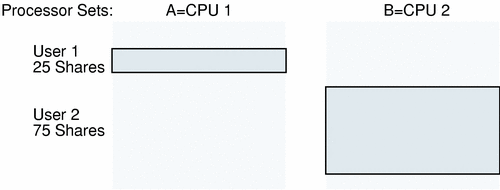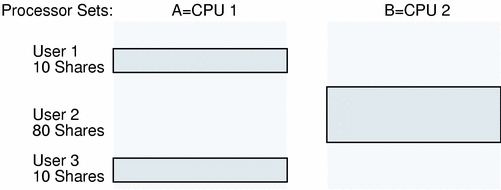The Role and Effect of Processor Sets
Even with the Solaris Resource Manager software in effect, processor sets can still play an important role in resource allocation. There might be cases in which a system must have hard limits applied to the resource policies. For example, a company may purchase a single 24-processor system, and then host two different business units from the same machine. Each of the business units pays for a proportion of the machine, 40 percent and 60 percent, for example. In this scenario, the administrator might want to establish that the business that pays for 40 percent of the machine never gets more than that share.
With processor sets, it is possible to divide the workloads into 40 percent and 60 percent by allocating 10 processors to the unit with 40 percent, and 14 processors to the unit with 60 percent.
When using processor sets with the Solaris Resource Manager product, it is important to understand the interaction between these two technologies. In some circumstances, the net effect might be different than anticipated.
A Simple Example
The following illustration shows a simple combination of Solaris Resource Manager and processor sets. In this example, processor sets and Solaris Resource Manager CPU shares are mixed.

User 1 has 25 Solaris Resource Manager shares and is restricted to processor set A (1 CPU). User 2 has 75 Solaris Resource Manager shares and is restricted to processor set B (1 CPU).
In this example, user 2 will consume its entire processor set (50 percent of the system). Because user 2 is only using 50 percent (rather than its allocated 75 percent), user 1 is able to use the remaining 50 percent. In summary, each user will be granted 50 percent of the system.
A More Complex Example
The following example shows a more complex scenario in which processor sets and Solaris Resource Manager CPU shares are mixed.

Users 1 and 3 have 10 Solaris Resource Manager shares each and are restricted to processor set A (1 CPU). User 2 has 80 Solaris Resource Manager shares and is restricted to processor set B (1 CPU).
In this example, user 2 will consume its entire processor set (50 percent of the system). Because user 2 is only using 50 percent (rather than its allocated 80 percent), users 1 and 3 are able to use the remaining 50 percent. This will mean that users 1 and 3 get 25 percent of the system, even though they are allocated only 10 shares each.
A Scenario to Avoid
The following scenario should be avoided.

In this scenario, one user has processes in both processor sets. User 1 has 20 Solaris Resource Manager shares and has processes in each processor set. User 2 has 80 Solaris Resource Manager shares and is restricted to processor set B (1 CPU).
In this example, user 1's first process will consume its entire processor set (50 percent of the system). Since user 2 is allowed 80 shares, user 2's process will consume its entire processor set (50 percent). Thus, user 1's second process will get no share of the CPU.
- © 2010, Oracle Corporation and/or its affiliates
